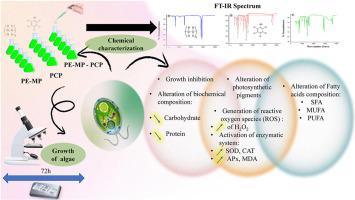Polyethylene microplastic modulates the toxicity of pentachlorophenol to the microalgae Isochrysis galbana, clone t-ISO
IF 8.1
2区 环境科学与生态学
Q1 ENVIRONMENTAL SCIENCES
引用次数: 0
Abstract
Pentachlorophenol (PCP) and polyethylene microplastic (PE-MP) have been designated as emerging and persistent pollutants, respectively. The combined effects of those pollutants are still unknown, especially to organisms like phytoplankton that may adsorb to their surface. Therefore, the purpose of this study was to investigate for the first time the effects of PE-MP alone and in combination with PCP on the microalgae Isochrysis galbana, clone t-ISO following 72 h of exposure. Photosynthetic pigments amounts, carotenoid, protein, carbohydrate and fatty acids have been assessed. Acute toxicity test showed that the 72 h median inhibition concentration (72 h-EC50) was 148.2, 0.66 and 087 mg L−1 for PE-MP, PCP and their mixture. The utmost effects in growth inhibition rates were noted with 0.5 and 1.25 mg L−1 PCP (23% and 85%, respectively), and 100 and 300 mg L−1 PE-MP (49% and 64%, respectively). Moreover, it was found that those concentrations had a major impact on the photosynthetic pigments, protein, carbohydrate, and fatty acids amounts in algal cells. Furthermore, levels of H2O2 and Malondialdehyde (MDA), as well as the activities of catalase (CAT), superoxide dismutase (SOD), and ascorbate peroxidase (APX), indicated the induction of an oxidative stress in algal cells. It appears that adding PE-MP at a no-effect concentration (25 mg L−1) reduces the toxicity caused by PCP due to its adsorption to polyethylene microplastics.

聚乙烯微塑料可调节五氯苯酚对微型藻类 Isochrysis galbana(克隆 t-ISO)的毒性。
五氯苯酚(PCP)和聚乙烯微塑料(PE-MP)已分别被指定为新兴污染物和持久性污染物。这些污染物的综合影响尚不清楚,尤其是对可能吸附在其表面的浮游植物等生物的影响。因此,本研究的目的是首次调查 PE-MP 单独和与五氯苯酚一起暴露 72 小时后对微藻类 Isochrysis galbana(克隆 t-ISO)的影响。对光合色素、类胡萝卜素、蛋白质、碳水化合物和脂肪酸的含量进行了评估。急性毒性试验表明,PE-MP、五氯苯酚及其混合物的 72 小时中位抑制浓度(72 小时-EC50)分别为 148.2、0.66 和 087 毫克/升。0.5 和 1.25 毫克/升五氯苯酚(分别为 23% 和 85%)以及 200 和 300 毫克/升 PE-MP(分别为 49% 和 64%)对生长抑制率的影响最大。此外,研究还发现,这些浓度对藻类细胞中的光合色素、蛋白质、碳水化合物和脂肪酸含量有重大影响。此外,H2O2 和丙二醛(MDA)的含量,以及过氧化氢酶(CAT)、超氧化物歧化酶(SOD)和抗坏血酸过氧化物酶(APX)的活性,都表明藻类细胞中存在氧化应激。在无效应浓度(25 毫克/升-1)下添加 PE-MP 似乎能降低五氯苯酚因吸附在聚乙烯微塑料上而产生的毒性。
本文章由计算机程序翻译,如有差异,请以英文原文为准。
求助全文
约1分钟内获得全文
求助全文
来源期刊

Chemosphere
环境科学-环境科学
CiteScore
15.80
自引率
8.00%
发文量
4975
审稿时长
3.4 months
期刊介绍:
Chemosphere, being an international multidisciplinary journal, is dedicated to publishing original communications and review articles on chemicals in the environment. The scope covers a wide range of topics, including the identification, quantification, behavior, fate, toxicology, treatment, and remediation of chemicals in the bio-, hydro-, litho-, and atmosphere, ensuring the broad dissemination of research in this field.
 求助内容:
求助内容: 应助结果提醒方式:
应助结果提醒方式:


